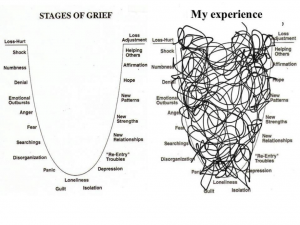
Grief – How To Support Your Body Whilst Grieving
GRIEF: ‘GO WITH THE FLOW WHILE MAKING SURE YOU SUPPORT YOUR BODY AS BEST YOU CAN’
Grief is hard to control, distressing and, at times, utterly overwhelming and painful. And the idea that there is a road map may be soothing and give us something to hang onto. However, it is an illusion.
Utter confusion
The five stages of grief by Elisabeth Kübler-Ross are often used to try and explain the grieving process. However, they were “never meant to help tuck messy emotions into neat packages” as she herself wrote in her last book ‘On Grief and Grieving’. All her research was actually carried out on dying patients, not the bereaved, which clearly alters the perspective.

While her stages of grief offer a loose framework and can provide a conversation starter, their misinterpretation has meant that many have tried to apply them step-by-step on bereaved people. This linear approach is, however, doing more harm than good as people can – inadvertently – place expectations on the bereaved to ‘be done’ with their grieving after a certain period of time.
I remember being completely and utterly at sea during the first 1.5 years of my grief journey, not knowing whether I was grieving correctly, getting confused time and again when my grief didn’t appear to become less, only different. Looking back, I suspect that I was just numb for a long time because of the traumatic way my husband died.
Understanding our body’s protective mechanisms
Our body (and brain) always try to protect us, and making us emotionally numb can be one way in which they try to stop us from being overwhelmed by our grief. The feeling of ‘depression’ that we can experience is a protective mechanism because when we are in a state of hyper-stress, as after the loss of our partner, we do need to slow down.

Therefore, don’t be surprised if you don’t feel much at first or only get hit by intermittent grief waves now and again. I have always felt weirdly relieved when this happens. This more than anything gives me an idea of where I am on my journey. The interval between these grief waves has become longer but they still hit ‘out of the blue’ and this is a common experience among bereaved people.
Also, don’t be surprised if you don’t cry as intensely as you would normally do when something bad has happened. My chiropractor always reassured me that my body is only ever going to release what it is ready to release. For me, this means that my grief only comes out in spurts and then stops again. I have come to accept that this is my body’s way of dealing with these intense emotions and to just go with the flow and cry whenever I feel like crying, ‘even’ now, three years later.
My take-away message
Expect the unexpected and grieve in whatever way feels right for you. However long this may take. And while you are dealing with your grief, look after your body as best you can so that it can support you while you are healing.

© All text and images Sabine Horner, Asana Nutrition
